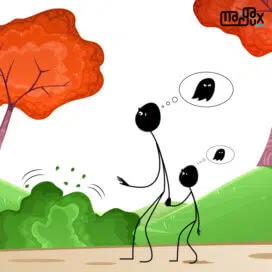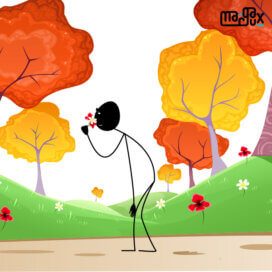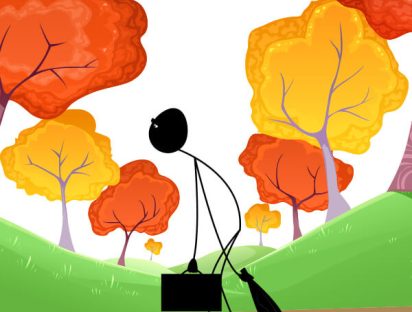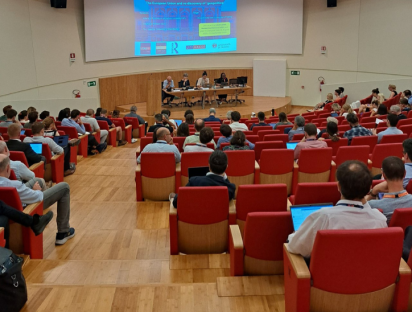In our previous articles, we explored the meaning of judgements of archaism that are made about social situations. It appeared that these judgements should be understood as reflecting visions, ways of being, and types of action that their authors consider unsuitable for the present time. Thus, to say that a practice is archaic is to affirm that it bears witness to the survival of a bygone past, a past in which the author of the judgement cannot recognise himself or herself. However, this survival of the past evokes another interpretation. It is based on the concept of archetype, which is the subject of our third exploration.

Let us begin with the “primitive” state of mind discussed in our previous article.
The psychiatrist and psychoanalyst Carl Gustav Jung stated that this state of mind should not be understood as being under the domination of consciousness. The thoughts that come to the primitive being do not result from the feeling that they would have to master their mental states: it results from their unconscious (1).
Now, and this is one of Jung’s most famous theses, this unconscious comprises two levels. Firstly, there is the personal unconscious, the content of which comes from experiences that the subject themself has lived through during their existence. Then there is the collective unconscious which, in Jung’s words, comprises “collective (and not personal) structural elements of the human psyche in general” (2).
The general character of this unconscious must be taken in a literal sense: it concerns all human beings. This may seem surprising when one considers the diversity of human cultures. But, according to Jung, the collective unconscious has been formed by experiences that have been lived at all times by each individual. If members of different cultures share them, it is because they arise from common problems and common motivations relating to self-preservation and the group, relationships with others, social organisation, education and reproduction (3).
Furthermore, the contents of the collective unconscious – or, more precisely, the capacity that each individual possesses to evoke these contents – are transmitted hereditarily.
Jung points out that this should come as no surprise. After all, the human body bears the traces of evolution. So just as modern man’s hand enables him to perform actions that were forbidden to his distant ancestors, so the collective unconscious has been forged to help him conduct his life in the social world.
The collective unconscious is not a repertoire of primordial experiences. Rather, it contains types that condense and schematise them, which Jung calls “archetypes.” “Primordial” here is a near-synonym for “archaic” and “primitive,” adjectives that Jung uses to describe the archetype, as in this passage where he states that “it represents or personifies certain instinctive premises in the dark, primitive psyche, in the real but invisible roots of consciousness” (5).
Every archetype designates an ancient or “original” type belonging to this collective unconscious where “primordial images which [are] universally present in the preconscious makeup of the human psyche” are found (6). However, Jung’s definitions of archetypes are not lacking in ambivalence, or even, for some researchers, in incoherence and contradiction (7). It is that it influences human actions without being able to be grasped as such. For an archetype cannot be perceived. It can only be seen through a conscious manifestation. It is certainly a “psychic organ” inscribed in the brain of every human being, but it must also and above all be understood as a vital and dynamic force that leads individuals confronted with social situations to relive primordial experiences (8). Basically it is only an “empty” element, “a possibility of representation which is given a priori,” in short it is a form, and it is only this form that is transmitted through heredity (9).
Archetypes manifest themselves to consciousness in an indirect way. In ancient contexts, i.e. before modernity, archetypes were somehow encapsulated in dogmas, secret formulas, symbols, as well as in myths and fairytales. This leads Jung to observe that “mankind has never lacked powerful images to lend magical aid against all the uncanny things that live in the depths of the psyche” (10).
However, in our world marked by the predominance of consciousness, the rejection of the unconscious into the depths of the soul, and the impoverishment of dogma, symbols and sacred images, archetypes manifest themselves in ways that are almost invisible, often incomprehensible and sometimes painful. Jung insists on the idea that “the archetype as such is a hypothetical and irrepresentable model” (11). In his view, modern psychology was born from this new situation.
These considerations allow us to put forward a hypothesis on a possible type of judgment of archaism: an archetype, both content and mode of manifestation of the collective unconscious, would guide the author of this judgment without them being aware of it (12). Nor would they be aware that the situation they are judging is a special case of the problems that have been encountered by human beings since time immemorial.
This hypothesis is not without its difficulties. Knowing which archetypes would guide the judgements of archaism is one of them. In the case, mentioned in previous articles, of the sales manager who asks a supplier for a box of cigars rather than allowing his company to benefit from a discount, the archetype of the cheat (which partly overlaps with the trickster discussed by Jung) could be evoked. The archetype would manifest itself in the mind of the observer who produces the judgement of archness by activating in their mind representations relating to cheating situations and the ancestral figure of the cheater.
This brings us to a second difficulty. It concerns the psychological reality of archetypes and their contribution to the functioning of the human mind. David Becker and Steven Neuberg have responded to this by attempting to place archetypes within the field of cognitive science (13).
According to them, archetypes are patterns of perception and action that are present in the memory of each individual and have a phylogenetic origin. They are evidence of an adaptation of human beings to the conditions of life in society.
Archetypes are more than prototypes, which are “the most typical members of a category” and which intervene in our representation of reality by activating representations in our mind when faced, for example, with a situation in which moral rules are violated, such as the cheater we have just mentioned. Archetypes are rather universal capacities or tendencies nurtured by the past and whose reliability, Becker and Neuberg note, is more important than prototypes because the latter depend on human cultures. The authors conclude their article by again reiterating their definition: “Archetypes are evolved proclivities to simulate and predict adaptive responses to recurring social problems.”
Becker and Neuberg’s recourse to Jung’s archetypes has been contested, notably by Ryan Boyd and his colleagues, firstly because of the lack of clarity of their statement, but also because, in the end, the use of the archetype concept does not seem necessary to them to describe the cognitive functioning of human beings (14).
If these criticisms are justified, they do not seem to us to compromise the validity of the hypothesis, which we have succinctly described and which can be summarised as follows with reference to the first case that motivated our exploration: the war in Ukraine is judged to be archaic because it evokes a set of representations, ancestral and universally inscribed in the human mind, relating to the devastating consequences of war.
Our hypothesis also applies to the other cases we have mentioned, such as the dishonest sales manager who asks for his box of cigars and the indecent manager who warns his team about possible maternity leave in the coming year: they may both refer to types of situations and characters that embody ancestral varieties of dishonesty and indecency, types that explain the judgements of archaism.
These types are ancient, primitive, perhaps common, mutatis mutandis, to all human cultures. But can they be assimilated to archetypes in the Jungian sense, i.e. to forms nested in the depths of the human soul? Despite the richness of Jung’s ideas, we can doubt it.
Références
(1) “The primitive cannot assert that he thinks; it is rather that ‘something thinks in him.’ The spontaneity of the act of thinking does not lie, causally, in his conscious mind, but in his unconscious.” (C. G. Jung, in Essays on a science of mythology: The myth of the divine child and the mysteries of Eleusis, Bollingen Series XXII, Pantheon Books, 1963.)
(2) Ibid.
(3) I draw here on David Becker and Steven Neuberg, “Archetypes reconsidered as emergent outcomes of cognitive complexity and evolved motivational systems,” Psychological Inquiry, 30(2), 2019, pp. 59-75. The authors mention other basic motivations.
(4) (I translate from the French) “It would be surprising if the psyche were the only biological phenomenon that did not reveal obvious traces of its developmental history” (C. G. Jung, Les racines de la conscience. Etudes sur l’archétype, Editions Buchet / Chastel, 1971).
(5) C. G. Jung, in Essays on a science of mythology, op. cit.
(6) C. G. Jung, “The phenomenology of the spirit in fairytales,” The Collected Works of C. G. Jung, Volume 9, part 1, Princeton University Press, 1969.
(7) “Even archetype advocates are keenly aware of the fact that Jung’s archetype theory is difficult to reconcile, even with itself—it is riddled with inconsistencies, contradictions, and fundamental misunderstandings of mathematical, biological, and philosophical principles” (R. L. Boyd, P. Pasca, and D. Conroy-Beam, “You’re only Jung once: Building generalized motivational systems theories using contemporary research on language,” Psychological Inquiry, 30(2), 2019, pp. 93-98).
(8) (I translate from the French) “The archetypes […] are not only the result of the imprints left by the experiences – types which are renewed in the course of the individual existence and of the life of humanity; but moreover, they behave […] like energetic centers, like forces or tendencies which push the subject to renew the same experiences” (C. G. Jung, Psychologie de l’inconscient, Georg, 1983).
(9) C. G. Jung, “On the concept of the archetype,” The Collected Works of C. G. Jung, op. cit. Jung offers an interesting comparison between the actualisation of this form, the archetype, and the determination of the shape of a crystal.
(10) C. G. Jung, “Archetypes of the collective unconscious,” The Collected Works of C. G. Jung, op. cit.
(11) Ibid.
(12) See the actual cases we proposed in our article “Why do we call a situation ‘archaic?’ (1).”
(13) D. V. Becker and S. L. Neuberg, “Archetypes reconsidered as emergent outcomes…,” op. cit.
(14) R. L. Boyd, P. Pasca, and D. Conroy-Beam, “You’re only Jung once…,” op. cit.




